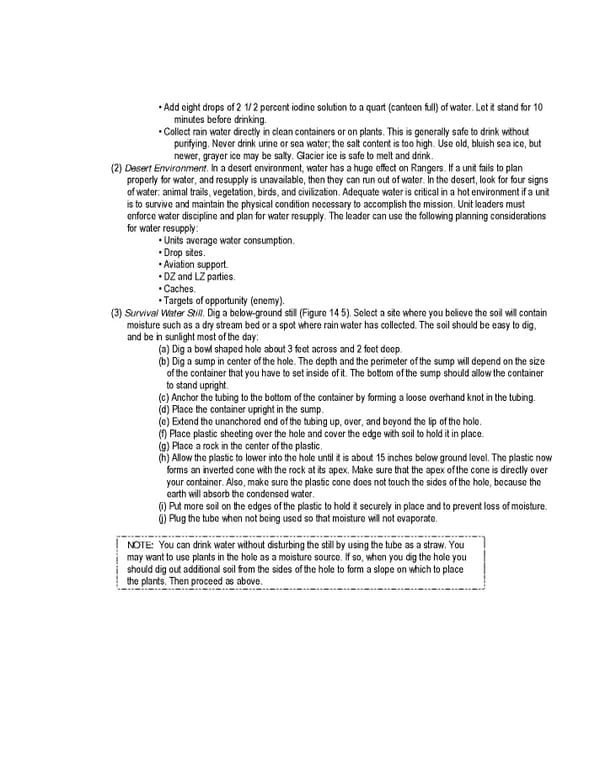• Add eight drops of 2 1/ 2 percent iodine solution to a quart (canteen full) of water. Let it stand for 10 minutes before drinking. • Collect rain water directly in clean containers or on plants. This is generally safe to drink without purifying. Never drink urine or sea water; the salt content is too high. Use old, bluish sea ice, but newer, grayer ice may be salty. Glacier ice is safe to melt and drink. (2) Desert Environment. In a desert environment, water has a huge effect on Rangers. If a unit fails to plan properly for water, and resupply is unavailable, then they can run out of water. In the desert, look for four signs of water: animal trails, vegetation, birds, and civilization. Adequate water is critical in a hot environment if a unit is to survive and maintain the physical condition necessary to accomplish the mission. Unit leaders must enforce water discipline and plan for water resupply. The leader can use the following planning considerations for water resupply: • Units average water consumption. • Drop sites. • Aviation support. • DZ and LZ parties. • Caches. • Targets of opportunity (enemy). (3) Survival Water Still. Dig a below-ground still (Figure 14 5). Select a site where you believe the soil will contain moisture such as a dry stream bed or a spot where rain water has collected. The soil should be easy to dig, and be in sunlight most of the day: (a) Dig a bowl shaped hole about 3 feet across and 2 feet deep. (b) Dig a sump in center of the hole. The depth and the perimeter of the sump will depend on the size of the container that you have to set inside of it. The bottom of the sump should allow the container to stand upright. (c) Anchor the tubing to the bottom of the container by forming a loose overhand knot in the tubing. (d) Place the container upright in the sump. (e) Extend the unanchored end of the tubing up, over, and beyond the lip of the hole. (f) Place plastic sheeting over the hole and cover the edge with soil to hold it in place. (g) Place a rock in the center of the plastic. (h) Allow the plastic to lower into the hole until it is about 15 inches below ground level. The plastic now forms an inverted cone with the rock at its apex. Make sure that the apex of the cone is directly over your container. Also, make sure the plastic cone does not touch the sides of the hole, because the earth will absorb the condensed water. (i) Put more soil on the edges of the plastic to hold it securely in place and to prevent loss of moisture. (j) Plug the tube when not being used so that moisture will not evaporate. NOTE: You can drink water without disturbing the still by using the tube as a straw. You may want to use plants in the hole as a moisture source. If so, when you dig the hole you should dig out additional soil from the sides of the hole to form a slope on which to place the plants. Then proceed as above.
 Ranger Handbook Page 255 Page 257
Ranger Handbook Page 255 Page 257